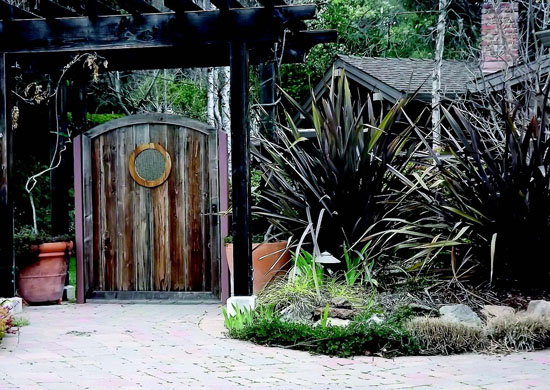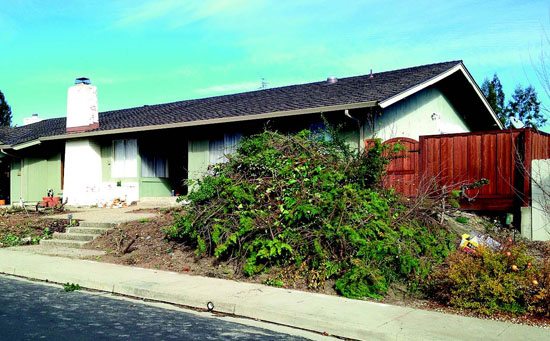|
|
Published Februray 25th, 2015
|
Curb Appeal
|
| The path of least resistance |
| By Cathy Dausman |
 |
| This round garden gate window echoes a Sleepy Hollow house front theme. Photo Cathy Dausman |
Beauty, it is said, is in the eye of the beholder - and a good first impression is priceless. But when it comes to a home's curb appeal, a little fresh paint, new plantings and a bit of bark dust can often work magic. Homeowners may take on a front-yard revision to freshen up an outdated look, to reduce water consumption, to list the home for sale or a combination of these. Some prefer to the do-it-yourself method; others enlist a landscaper.
 Tom Reuter of Reuter Landscaping Contractors suggests reimagining a front yard design "after 10 to 15 years." Reuter has worked with clients in the Lamorinda area for decades; he formed his company after first working at a local nursery. He recommends homeowners spend at least one week annually going through their yards to clean, trim and re-plant, ensuring that there is a reason for every flower and shrub.
Tom Reuter of Reuter Landscaping Contractors suggests reimagining a front yard design "after 10 to 15 years." Reuter has worked with clients in the Lamorinda area for decades; he formed his company after first working at a local nursery. He recommends homeowners spend at least one week annually going through their yards to clean, trim and re-plant, ensuring that there is a reason for every flower and shrub.
 Even though juniper is drought and deer resistant, Reuter has moved away from planting it. Tam Juniper, a popular choice 30 or 40 years ago, can become "a rat's nest" when it overtakes a yard, he says, while a line of Italian Cypress grows "obnoxious" over time. Michael Saputo knows just how juniper gets out of hand. His Orinda neighbors once nicknamed his place "the juniper house" because his aunt and uncle, who bought the house in 1953, blanketed their entire giant front yard with it.
Even though juniper is drought and deer resistant, Reuter has moved away from planting it. Tam Juniper, a popular choice 30 or 40 years ago, can become "a rat's nest" when it overtakes a yard, he says, while a line of Italian Cypress grows "obnoxious" over time. Michael Saputo knows just how juniper gets out of hand. His Orinda neighbors once nicknamed his place "the juniper house" because his aunt and uncle, who bought the house in 1953, blanketed their entire giant front yard with it.
 "It was just awful," he says. Saputo had it removed by a landscaper about six years ago, replacing it with a unique, drought-friendly design, with a flagstone entry, lighting and drip irrigation to carefully ration water. The irrigation system is being reworked with Mondo grass installed. "It's a look that [water supplier EBMUD] likes," Saputo says with pride. Although his plants are not in their prime during winter months he thinks his front yard is "the best landscaped yard in Sleepy Hollow."
"It was just awful," he says. Saputo had it removed by a landscaper about six years ago, replacing it with a unique, drought-friendly design, with a flagstone entry, lighting and drip irrigation to carefully ration water. The irrigation system is being reworked with Mondo grass installed. "It's a look that [water supplier EBMUD] likes," Saputo says with pride. Although his plants are not in their prime during winter months he thinks his front yard is "the best landscaped yard in Sleepy Hollow."
 Realtors will tell you that landscaping is an integral part of the home-for-sale formula. "It usually looks best when it looks established and natural," says Tom Stack of Orinda's Coldwell Banker office. "Does the paint merge with the landscaping? Does the home sit well on its lot?" he asks. "At a minimum, weed, plant [and] invigorate the garden," he says, and arrange "pots with flowers on the porch. Perhaps [add] some bark in the planting area to give it a uniform color." Stack's chore list also includes pruning trees and removing dead limbs. He says the path to the door should be clear.
Realtors will tell you that landscaping is an integral part of the home-for-sale formula. "It usually looks best when it looks established and natural," says Tom Stack of Orinda's Coldwell Banker office. "Does the paint merge with the landscaping? Does the home sit well on its lot?" he asks. "At a minimum, weed, plant [and] invigorate the garden," he says, and arrange "pots with flowers on the porch. Perhaps [add] some bark in the planting area to give it a uniform color." Stack's chore list also includes pruning trees and removing dead limbs. He says the path to the door should be clear.
 There's an added safety benefit to decluttering vegetation out front. "Front door visibility and exposure minimizes risk of front door intrusion from burglars," says Moraga Chief of Police Robert Priebe. "Anything providing cover from passersby on the street helps anyone trying to get in your home via the front door."
There's an added safety benefit to decluttering vegetation out front. "Front door visibility and exposure minimizes risk of front door intrusion from burglars," says Moraga Chief of Police Robert Priebe. "Anything providing cover from passersby on the street helps anyone trying to get in your home via the front door."
 "I tell my sellers you only have one chance to make a first impression," emphasizes Diane Reilly of Alain Pinel Realtors. "I can't tell you how many times I've pulled up to a home that meets all the buyer needs but when they see an unattractive or cluttered front yard they say, 'We don't need to go inside this one.'" Reilly explains that most yard work can be accomplished with more elbow grease than cash. "Keep grass cut, edges trimmed and trees pruned. Remove old woody shrubs like junipers. Plant colorful seasonal plants - all one vibrant color clustered in a spot that will draw the eye to the front door. Use dark bark to fill in unplanted spaces," she says.
"I tell my sellers you only have one chance to make a first impression," emphasizes Diane Reilly of Alain Pinel Realtors. "I can't tell you how many times I've pulled up to a home that meets all the buyer needs but when they see an unattractive or cluttered front yard they say, 'We don't need to go inside this one.'" Reilly explains that most yard work can be accomplished with more elbow grease than cash. "Keep grass cut, edges trimmed and trees pruned. Remove old woody shrubs like junipers. Plant colorful seasonal plants - all one vibrant color clustered in a spot that will draw the eye to the front door. Use dark bark to fill in unplanted spaces," she says.
 Reilly suggests painting home exteriors every seven or eight years. "If not the whole house, at least paint the trim and the front door," she says, adding that a fresh coat of paint in a neutral color is money well spent. The home should look "crisp, clean and uncluttered," Reilly says. "Even if a homeowner is not selling, these affordable improvements can be done over time to make the home one of the nicest on the block."
Reilly suggests painting home exteriors every seven or eight years. "If not the whole house, at least paint the trim and the front door," she says, adding that a fresh coat of paint in a neutral color is money well spent. The home should look "crisp, clean and uncluttered," Reilly says. "Even if a homeowner is not selling, these affordable improvements can be done over time to make the home one of the nicest on the block."
 Cindy Glover of Moraga understands the time commitment for her do-it-yourself yard project. Glover spent two years discussing the look she wanted for her former front yard. The original landscaping was "lawn and path-oriented" with a "cookie-cutter" look.
Cindy Glover of Moraga understands the time commitment for her do-it-yourself yard project. Glover spent two years discussing the look she wanted for her former front yard. The original landscaping was "lawn and path-oriented" with a "cookie-cutter" look.
 The first piece she tackled was the pathway and its surrounding hardscape; it would become "the bones" of the project. Glover envisioned a wide path leading straight to her front door with a low, curved "eyebrow" wall and a built-in mailbox of stone to match the stone on the house. Spots for manzanita and maple trees were reserved. The remaining spaces were filled in mostly with drought resistant flowers and grasses, ensuring that "any mistakes made were small." A new roof with a mix of colors and bright metal trim was installed, and a new front door completed the look Glover calls "timeless."
The first piece she tackled was the pathway and its surrounding hardscape; it would become "the bones" of the project. Glover envisioned a wide path leading straight to her front door with a low, curved "eyebrow" wall and a built-in mailbox of stone to match the stone on the house. Spots for manzanita and maple trees were reserved. The remaining spaces were filled in mostly with drought resistant flowers and grasses, ensuring that "any mistakes made were small." A new roof with a mix of colors and bright metal trim was installed, and a new front door completed the look Glover calls "timeless."
 Roger and Patti Witalice's 1950s Orinda home had changed hands once or twice before they bought it in 1979, but the view from the street was the same, consisting of "a flat porch, hidden doorway and concrete walkway," says Patti Witalice. "There were three huge pine trees, a briar bush of pyracantha and wild roses," while the front door was "smashed into a corner." They hired a landscaper in 2006. The new look focuses on the front door, with a curved walkway, an earthen berm to shield the street view and a mix of plant color and textures. The New Zealand flax plantings create "a visual barrier" with a "comforting sense of privacy." The round window in the gate echoes the Sleepy Hollow practice of a round window on the front of the house, she says.
Roger and Patti Witalice's 1950s Orinda home had changed hands once or twice before they bought it in 1979, but the view from the street was the same, consisting of "a flat porch, hidden doorway and concrete walkway," says Patti Witalice. "There were three huge pine trees, a briar bush of pyracantha and wild roses," while the front door was "smashed into a corner." They hired a landscaper in 2006. The new look focuses on the front door, with a curved walkway, an earthen berm to shield the street view and a mix of plant color and textures. The New Zealand flax plantings create "a visual barrier" with a "comforting sense of privacy." The round window in the gate echoes the Sleepy Hollow practice of a round window on the front of the house, she says.
 In short, curb appeal means keeping things fresh, simple and clean. After all, the goal is "to show off the home," Stack says.
In short, curb appeal means keeping things fresh, simple and clean. After all, the goal is "to show off the home," Stack says.

|
 |
| A "before" front yard, and do-it-yourself project for Moraga's Lau family. Removing 40-year-old juniper takes work! Photo Ted Lau |
|
|
|
|
|
|
| |
|
|
|
|






